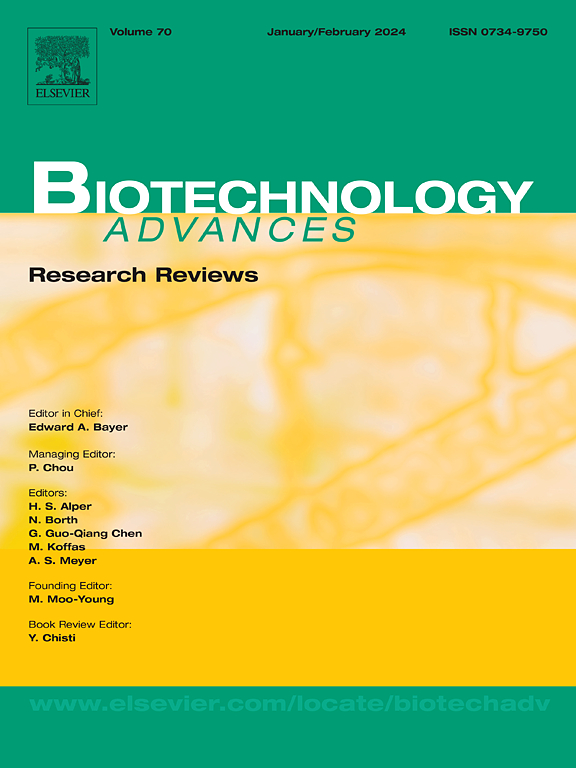Chemical imaging of lignocellulosic biomass: Mapping plant chemistry
IF 12.5
1区 工程技术
Q1 BIOTECHNOLOGY & APPLIED MICROBIOLOGY
引用次数: 0
Abstract
Lignocellulosic biomass (LB), which encompasses various plant samples, requires thorough characterization to optimize its use as a carbon resource. Chemical imaging simultaneously provides chemical and spatial information, offering significant benefits for LB analysis. This review presents an overview of the most advanced techniques for achieving this goal. By combining spectrometry and microscopy, microspectroscopy enables chemical imaging using various irradiation sources (IR, Raman, fluorescence, among others), allowing for the quantitative mapping of key LB components such as lignins, cellulose, and hemicelluloses. Mass Spectrometry Imaging (MSI) generates a mass spectrum for each spot of a sample thereby creating a chemical image pixel-by-pixel. MSI techniques like Matrix-Assisted Laser Desorption/Ionization (MALDI), down to 2–5 μm spatial resolution, and Secondary Ion Mass Spectrometry (SIMS), down to 300 nm for molecular analysis, effectively map small molecules in LB. In contrast, Desorption ElectroSpray Ionization (DESI) has been applied to plant extracts but remains largely unexplored for LB applications. Nuclear Magnetic Resonance (NMR) provides insight into various LB properties too. Solid-state NMR (ssNMR) and Dynamic Nuclear Polarization (DNP) help elucidate the structure of LB, sometimes aided by 3D atomistic modeling, whereas micro–Magnetic Resonance Imaging (micro-MRI) and Time-Domain (TD-NMR) probe the impact of water on LB properties.

木质纤维素生物质的化学成像:植物化学制图。
木质纤维素生物质(LB),其中包括各种植物样品,需要彻底的表征,以优化其作为碳资源的使用。化学成像同时提供化学和空间信息,为LB分析提供了显著的好处。本文概述了实现这一目标的最先进的技术。通过结合光谱和显微镜,微光谱学可以使用各种辐照源(红外、拉曼、荧光等)进行化学成像,从而可以定量绘制关键LB成分,如木质素、纤维素和半纤维素。质谱成像(MSI)为样品的每个点生成质谱,从而逐像素创建化学图像。MSI技术,如基质辅助激光解吸/电离(MALDI),低至2-5 μm的空间分辨率,以及二次离子质谱(SIMS),低至300 nm的分子分析,有效地绘制LB中的小分子。相比之下,解吸电喷雾电离(DESI)已经应用于植物提取物,但在LB应用中仍未得到很大的探索。核磁共振(NMR)也提供了对各种LB特性的洞察。固态核磁共振(ssNMR)和动态核极化(DNP)有助于阐明LB的结构,有时借助3D原子建模,而微磁共振成像(micro-MRI)和时域(TD-NMR)则探测水对LB性质的影响。
本文章由计算机程序翻译,如有差异,请以英文原文为准。
求助全文
约1分钟内获得全文
求助全文
来源期刊

Biotechnology advances
工程技术-生物工程与应用微生物
CiteScore
25.50
自引率
2.50%
发文量
167
审稿时长
37 days
期刊介绍:
Biotechnology Advances is a comprehensive review journal that covers all aspects of the multidisciplinary field of biotechnology. The journal focuses on biotechnology principles and their applications in various industries, agriculture, medicine, environmental concerns, and regulatory issues. It publishes authoritative articles that highlight current developments and future trends in the field of biotechnology. The journal invites submissions of manuscripts that are relevant and appropriate. It targets a wide audience, including scientists, engineers, students, instructors, researchers, practitioners, managers, governments, and other stakeholders in the field. Additionally, special issues are published based on selected presentations from recent relevant conferences in collaboration with the organizations hosting those conferences.
 求助内容:
求助内容: 应助结果提醒方式:
应助结果提醒方式:


